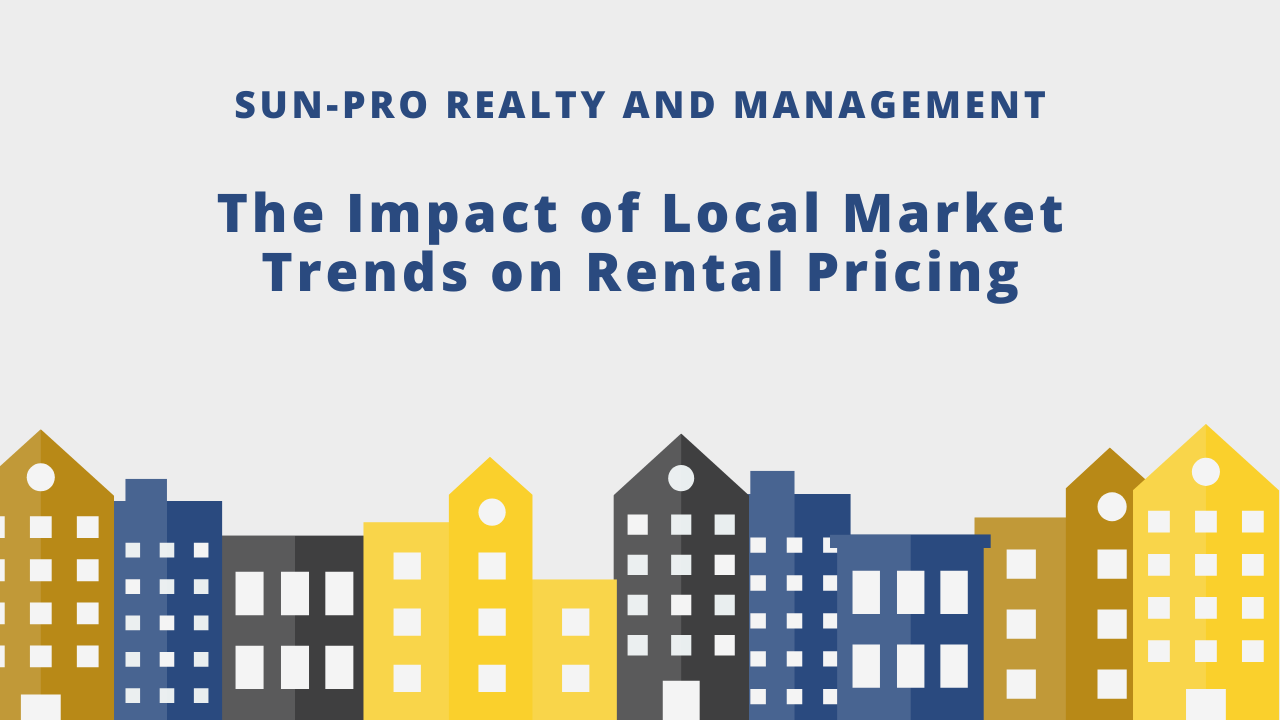
Key Takeaways
- Local Data Drives Pricing Power: Rental markets move in cycles influenced by supply, demand, job growth, and seasonal patterns, making real-time local data essential for accurate pricing.
- Neighborhood Trends Matter More Than Citywide Averages: Conditions can vary dramatically from one area to the next, so understanding micro-market shifts helps landlords avoid guesswork and set competitive, realistic rents.
- Staying Informed Protects Income: Regularly tracking trends—and getting guidance from Sun-Pro Realty and Management—helps landlords reduce vacancy, stay compliant, and adjust pricing before the market moves against them.
Local market trends can make or break a landlord’s rental strategy. Prices rise, prices fall, and sometimes they stay oddly still. If you have ever wondered why a property that rented easily last year suddenly sits empty this year, the answer is usually found in the local data that shifts beneath the surface.
Sun-Pro Realty and Management put together this article to help landlords understand these changes and use them to make smarter decisions that protect their income and reduce risk.
How Local Trends Shape What You Can Charge
The Rental Market Moves in Cycles
Every rental market moves in clear cycles. In areas like Orlando and Central Florida, demand often peaks during job growth periods or when major developments bring in new residents.
When more people move in than there are homes available, rent prices climb. When new construction hits the market or hiring slows, prices often cool down. Tracking these cycles helps landlords avoid guessing and instead adjust prices with intention.
Supply and Demand Set the Pace
Supply and demand are still the strongest forces in rental pricing. If your neighborhood sees rising construction or a sudden wave of short-term rental conversions turning into long-term rentals, the market supply increases. More supply creates competition, and tenants have more choices. That usually pushes rents down or makes increases harder to justify.
On the other hand, if supply is tight and homes are leasing quickly, landlords can price with more confidence. The key is staying aware of what is happening one street over instead of relying on last year’s data.

Job Growth and Population Shifts Matter
Local hiring trends have a huge influence on rental demand. When employers expand or new companies move into a region, the pool of renters tends to grow. Central Florida often sees this when tourism rebounds or when healthcare and tech jobs expand. More jobs usually mean more tenants, which supports stronger rental pricing.
Population changes matter too. For example, if a neighborhood becomes more attractive to families due to new schools or improved public services, rental homes in that area might see higher and more stable demand.
Seasonal Patterns Should Be Part of Your Plan
Some regions, including many parts of Florida, experience clear seasonal rental patterns. Summer often brings relocations. Winter can slow down demand unless you operate in a market with seasonal workers.
Timing your pricing and marketing to match these cycles helps reduce vacancy and protects your annual income.
If you list during a low-demand season, expect to adjust your price or offer incentives. Listing during peak season gives you stronger pricing power. Many landlords miss this simple timing advantage.
Local Regulations Influence Pricing Power
Orlando and surrounding areas continue to adjust their rental-related rules from time to time.
Caps on certain fees, changes in tenant screening rules, or adjustments to eviction timelines can affect how landlords structure their pricing. When the law restricts flexibility, pricing must adapt to reduce risk.

Staying compliant is not optional. Fines and legal issues are costly. Smart pricing only works when it fits within the current legal framework. This is where professional guidance becomes valuable because keeping up with changing policies takes time and attention.
Property Condition Stays Important
Even in a strong market, tenants compare properties side by side. Clean, updated homes with well-functioning systems can command higher rents and lease faster. If local homes are being renovated or upgraded, the bar rises. If yours falls behind, pricing must adjust.
Small improvements such as fresh paint, new hardware, or updated lighting can help close that gap. Larger updates may be necessary if nearby homes are setting a new standard. Competitive pricing starts with a competitive home.
Location-Specific Trends Create Differences Within the Same City
Not every neighborhood in Orlando moves at the same speed. Some areas experience rapid appreciation due to new commercial development. Others slow down due to rising insurance costs or school zone changes. Understanding the specific drivers inside your micro-market is far more effective than relying on broad city-level data.
For example, a property near expanding medical facilities may attract stable, long-term tenants at higher price points. Another property only a short distance away may face slower demand due to limited public transit or older infrastructure. Knowing these differences lets you set prices based on facts rather than assumptions.

Data-Driven Adjustments Keep You Ahead
Rental pricing is never a one-and-done task. The most successful landlords review market trends regularly. Smart adjustments protect your occupancy and your income.
Some key indicators to track include:
- Average days on market for rentals in your area.
- Price changes on similar homes.
- New construction or converted rental supply.
- Shifts in tenant preferences.
- Local economic reports related to hiring.
Keeping an eye on these trends helps you stay steady even when the market shifts suddenly.
Bottom Line
Local market trends influence every step of the rental pricing process. Supply and demand, job growth, seasonal shifts, neighborhood changes, and local rules all play a role. When landlords stay informed and adjust with the market instead of reacting too late, they protect their revenue, attract better tenants, and avoid long vacancies.
Sun-Pro Realty and Management helps landlords stay ahead of these shifts by tracking real-time data, monitoring local trends, and adjusting pricing strategies based on experience in the Orlando and Central Florida region.
If you want support setting strong rental prices, reducing vacancy, and managing your property with confidence, reach out to Sun-Pro Realty and Management today.
